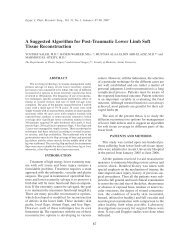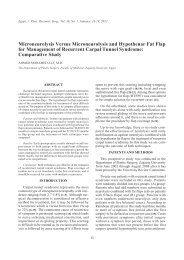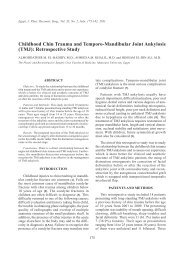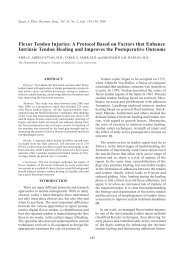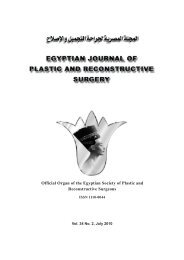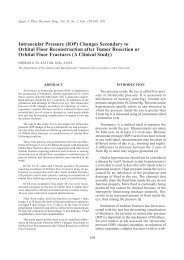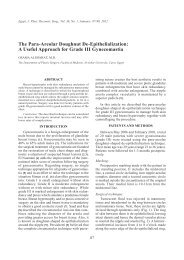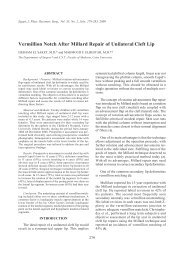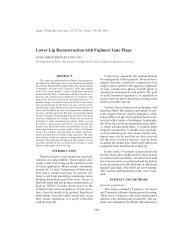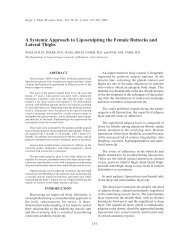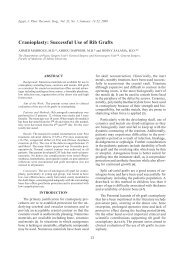The Lateral Supramalleolar Flap for Reconstruction of the ... - ESPRS
The Lateral Supramalleolar Flap for Reconstruction of the ... - ESPRS
The Lateral Supramalleolar Flap for Reconstruction of the ... - ESPRS
You also want an ePaper? Increase the reach of your titles
YUMPU automatically turns print PDFs into web optimized ePapers that Google loves.
Egypt, J. Plast. Reconstr. Surg., Vol. 34, No. 2, July: 167-171, 2010<br />
<strong>The</strong> <strong>Lateral</strong> <strong>Supramalleolar</strong> <strong>Flap</strong> <strong>for</strong> <strong>Reconstruction</strong> <strong>of</strong><br />
<strong>the</strong> Distal Leg and Foot<br />
MAGDY ABD AL MOKTADER, M.D.; MONA HASSAN, M.D.; WAEL AYAD, M.D.;<br />
TAREK ELBANOBY, M.D. and ESSAM TAMAN, M.D.<br />
<strong>The</strong> Department <strong>of</strong> Plastic and Reconstructive Surgery, Faculty <strong>of</strong> Medicine, Al-Azhar University.<br />
ABSTRACT<br />
We describe our experience and evaluate <strong>the</strong> reliability<br />
<strong>of</strong>, <strong>the</strong> lateral supramalleolar flap that was used in 16 patients<br />
<strong>for</strong> reconstruction <strong>of</strong> <strong>the</strong> distal leg and foot. <strong>The</strong>re were 10<br />
men and 6 women, age range 2-60 years. <strong>The</strong> causes <strong>of</strong> <strong>the</strong><br />
skin defects included trauma, deep burn and diabetic ulcer.<br />
Sites <strong>of</strong> <strong>the</strong> defects were <strong>the</strong> lower leg, over <strong>the</strong> malleoli and<br />
in front <strong>of</strong> <strong>the</strong> ankle. Fourteen flaps survived and provided<br />
satisfactory coverage <strong>of</strong> <strong>the</strong> defect. Two flaps showed partial<br />
necrosis and were treated conservatively. We think that <strong>the</strong><br />
lateral supra-malleolar flaps a good way to reconstruct s<strong>of</strong>t<br />
tissue defects <strong>of</strong> <strong>the</strong> lower extremity. It has a large skin paddle<br />
and a wide rotation arc.<br />
INTRODUCTION<br />
<strong>Reconstruction</strong> <strong>of</strong> s<strong>of</strong>t tissue defects <strong>of</strong> <strong>the</strong><br />
lower extremity is a common and challenging<br />
problem. Because <strong>of</strong> <strong>the</strong> limited availability <strong>of</strong><br />
local tissue, particularly in <strong>the</strong> lower leg and foot,<br />
<strong>the</strong> use <strong>of</strong> distant flaps <strong>for</strong> covering those defects<br />
<strong>of</strong>ten looks necessary. Cross leg flaps have been<br />
used in <strong>the</strong> past, but have few indication nowadays.<br />
Free tissue transfer may <strong>of</strong>fer <strong>the</strong> best surgical<br />
option in most cases, use <strong>of</strong> free flaps, however,<br />
is always associated with risk at <strong>the</strong> anastomosis.<br />
As well as <strong>the</strong> free transfer techniques tack long<br />
time. Axial pedicle flaps harvested from <strong>the</strong> leg<br />
can <strong>of</strong>ten provide good and safe reconstructive<br />
solutions with relatively simpler techniques [1].<br />
<strong>The</strong> lateral supramalleolar flap is one <strong>of</strong> <strong>the</strong><br />
series <strong>of</strong> flaps that has been described in <strong>the</strong> last<br />
decades and are based on <strong>the</strong> secondary arteries<br />
<strong>of</strong> <strong>the</strong> limb. It is a fasciocutaneous flap that is<br />
raised on <strong>the</strong> lateral aspect <strong>of</strong> <strong>the</strong> lower leg and it<br />
is usually used as a distally-based pedicle flap <strong>for</strong><br />
covering defects on <strong>the</strong> lower third <strong>of</strong> <strong>the</strong> leg and<br />
<strong>the</strong> foot [2].<br />
167<br />
Surgical anatomy:<br />
<strong>The</strong> lateral supramalleolar flap is a fasciocutaneous<br />
flap raised on <strong>the</strong> distal per<strong>for</strong>ating branch<br />
<strong>of</strong> <strong>the</strong> peroneal artery as its vascular pedicle. Masquelet<br />
et al., showed that <strong>the</strong> per<strong>for</strong>ating branch<br />
<strong>of</strong> <strong>the</strong> posterior peroneal artery consistently emerges<br />
from a groove between <strong>the</strong> tibia and <strong>the</strong> fibula,<br />
just proximal to <strong>the</strong> distal tibi<strong>of</strong>ibular ligament<br />
and can be found 5cm above <strong>the</strong> lateral malleolus.<br />
It divides into a superficial (ascending) cutaneous<br />
and a deep descending branch shortly after per<strong>for</strong>ating<br />
<strong>the</strong> interosseous membrane. <strong>The</strong> superficial<br />
cutaneous branch supplies a skin territory approximately<br />
12.0-18.0cm in length and 9.0cm in width,<br />
corresponding to an area on <strong>the</strong> lower half <strong>of</strong> <strong>the</strong><br />
leg from <strong>the</strong> tibial crest to <strong>the</strong> posterior margin <strong>of</strong><br />
<strong>the</strong> fibula [3].<br />
MATERIAL AND METHODS<br />
Sixteen patients with various defects <strong>of</strong> <strong>the</strong><br />
distal leg and foot caused by different etiological<br />
factors were managed by lateral supramalleolar<br />
flap. A total <strong>of</strong> 16 patients admitted during <strong>the</strong><br />
period <strong>of</strong> September’ 2007 to May’ 2009 with<br />
lower limb defect/wound with exposed bone (tibia/<br />
fibula) and/or in front <strong>of</strong> <strong>the</strong> ankle joint. <strong>The</strong> study<br />
was conducted in <strong>the</strong> department <strong>of</strong> Plastic Surgery,<br />
in Al-Azhar University Hospital.<br />
<strong>The</strong> patients were submitted to a preoperative<br />
mapping study with echodoppler to identify <strong>the</strong><br />
closest per<strong>for</strong>ating vessels to <strong>the</strong> injury margin.<br />
Once per<strong>for</strong>ating vessels topography was identified,<br />
<strong>the</strong>se were outlined with a dermographic pen. Based<br />
on this previous mapping, patches were designed<br />
on donor areas considering <strong>the</strong> longitudinal axis
168 Vol. 34, No. 2 / <strong>The</strong> <strong>Lateral</strong> <strong>Supramalleolar</strong> <strong>Flap</strong> <strong>for</strong> <strong>Reconstruction</strong><br />
<strong>of</strong> <strong>the</strong> main vessel, as well as <strong>the</strong> length and width<br />
required <strong>for</strong> covering <strong>the</strong> skin defect without tension.<br />
Surgical technique:<br />
<strong>The</strong> patient is placed supine with a roll or a<br />
pillow placed under <strong>the</strong> ipsilateral hip. Assessment<br />
<strong>of</strong> <strong>the</strong> defect is carried out and <strong>the</strong> size <strong>of</strong> <strong>the</strong> flap<br />
marked within <strong>the</strong> vascular territory. A hand-held<br />
Doppler probe can be used to locate <strong>the</strong> per<strong>for</strong>ating<br />
branch, and its position is marked. A tourniquet is<br />
used during <strong>the</strong> dissection. <strong>The</strong> ulcer is excised<br />
and <strong>the</strong> defect thoroughly irrigated. <strong>The</strong> margins<br />
<strong>of</strong> <strong>the</strong> flap are <strong>the</strong>n incised down to <strong>the</strong> deep fascia.<br />
<strong>The</strong> deep fascia is incised and <strong>the</strong> flap raised<br />
proximally to distally in <strong>the</strong> sub-fascial plane to<br />
locate <strong>the</strong> per<strong>for</strong>ator. Once <strong>the</strong> per<strong>for</strong>ator is located<br />
and preserved, <strong>the</strong> remainder <strong>of</strong> <strong>the</strong> flap is raised<br />
(Fig. 2). <strong>The</strong> flap is <strong>the</strong>n rotated into <strong>the</strong> defect<br />
based on its vascular pedicle. A drain is placed<br />
under <strong>the</strong> flap and <strong>the</strong> flap can <strong>the</strong>n be sutured in<br />
place. <strong>The</strong> donor can be closed directly if <strong>the</strong> width<br />
<strong>of</strong> <strong>the</strong> flap less than 3cm. O<strong>the</strong>rwise, A split-<br />
(A)<br />
(C)<br />
thickness skin graft is harvested and secured onto<br />
<strong>the</strong> secondary defect (Figs. 1,2,3). <strong>The</strong> wounds are<br />
dressed [4].<br />
RESULTS<br />
<strong>The</strong> lateral supramalleolar flaps were per<strong>for</strong>med<br />
in 16 cases from 2007 to 2009. Of <strong>the</strong>se 10 were<br />
males and 6 were females. Ages ranged from 2<br />
years to 60 years with an average <strong>of</strong> 38. <strong>The</strong> flaps<br />
were successful in 14 cases. <strong>The</strong> take <strong>of</strong> <strong>the</strong> skin<br />
graft on <strong>the</strong> donor defect was good in all cases.<br />
Complications such as marginal necrosis <strong>of</strong> <strong>the</strong><br />
flap were encountered in two cases and were treated<br />
conservatively. Active movement was encouraged<br />
after 1 month.<br />
<strong>The</strong> follow-up period ranged from 1 to 3 years.<br />
In general, <strong>the</strong> texture, thickness and color <strong>of</strong> <strong>the</strong><br />
flaps matched <strong>the</strong> surrounding, and patients were<br />
satisfied with <strong>the</strong> results. <strong>The</strong> thickness <strong>of</strong> <strong>the</strong> flap<br />
was suitable to cover <strong>the</strong> dorsum <strong>of</strong> <strong>the</strong> foot, medial<br />
and lateral malleoli (Figs. 1,2,3).<br />
Fig. (1): (A) Post-traumatic s<strong>of</strong>t tissue defect over <strong>the</strong> distal part <strong>of</strong> tibia that is exposing <strong>the</strong> underlying bone in 36-years old<br />
woman. (B) Design <strong>of</strong> <strong>the</strong> flap. (C) Elevation <strong>of</strong> <strong>the</strong> flap. (D) Final result 3 months later.<br />
(B)<br />
(D)
Egypt, J. Plast. Reconstr. Surg., July 2010 169<br />
(A)<br />
(C)<br />
Fig. (2): (A) Post-traumatic s<strong>of</strong>t tissue defect over <strong>the</strong> medial malleolus that is exposing<br />
<strong>the</strong> underlying bone in 30-years old man. (B) Design <strong>of</strong> <strong>the</strong> flap. (C) Elevation <strong>of</strong><br />
<strong>the</strong> flap showing per<strong>for</strong>ating branch <strong>of</strong> peroneal artery. (D) Final resul at 7 months.<br />
(A) (B) (C) (D)<br />
Fig. (3): (A) Post-burn contracture in front <strong>of</strong> <strong>the</strong> right ankle in 35-years old woman with<br />
dorsiflection <strong>of</strong> foot. (B) Design <strong>of</strong> <strong>the</strong> flap 5x12cm. (C) Elevation <strong>of</strong> <strong>the</strong> distally<br />
based flap. (D) Final result after 1 year.<br />
(B)<br />
(D)
170 Vol. 34, No. 2 / <strong>The</strong> <strong>Lateral</strong> <strong>Supramalleolar</strong> <strong>Flap</strong> <strong>for</strong> <strong>Reconstruction</strong><br />
Table (1): Patients data.<br />
Patient<br />
1<br />
2<br />
3<br />
4<br />
5<br />
6<br />
7<br />
8<br />
9<br />
10<br />
11<br />
12<br />
13<br />
14<br />
15<br />
16<br />
Age<br />
20<br />
43<br />
2<br />
33<br />
38<br />
37<br />
43<br />
57<br />
8<br />
59<br />
60<br />
60<br />
30<br />
60<br />
18<br />
36<br />
DISCUSSION<br />
Gender<br />
M<br />
M<br />
M<br />
M<br />
M<br />
M<br />
M<br />
M<br />
M<br />
M<br />
F<br />
F<br />
F<br />
F<br />
F<br />
F<br />
Etiology<br />
Traumatic<br />
Traumatic<br />
Deep burn<br />
Traumatic<br />
Traumatic<br />
Traumatic<br />
Deep burn<br />
Diabetes<br />
Traumatic<br />
Diabetes<br />
Diabetes<br />
Pressure<br />
Traumatic<br />
Pressure<br />
Deep burn<br />
Traumatic<br />
Deep skin injuries <strong>of</strong> <strong>the</strong> leg's distal third will<br />
certainly leave tendons, vasculonervous bundles,<br />
and bones exposed, which must be protected with<br />
good quality and good vascularization tissues so<br />
as to prevent deep infections and deterioration <strong>of</strong><br />
such structures. Skin grafts are contraindicated in<br />
<strong>the</strong>se circumstances. Muscle flaps, such as soleus<br />
and gastrocnemius, are restricted <strong>for</strong> use to proximal<br />
two thirds <strong>of</strong> <strong>the</strong> leg [5].<br />
At this level, <strong>the</strong> well known alternatives are<br />
<strong>the</strong> islands <strong>of</strong> reverse-flow pedicle flap, microsurgical<br />
flap. <strong>The</strong> disadvantages <strong>of</strong> free flaps, <strong>of</strong><br />
course, are that <strong>the</strong>y require a significant operative<br />
time (4 to 8 hours) and healthy recipient vessels.<br />
In addition, <strong>the</strong>re is <strong>the</strong> donor-site morbidity to<br />
consider and a prolonged hospital stay that usually<br />
requires one night in <strong>the</strong> intensive care unit <strong>for</strong><br />
flap monitoring. <strong>The</strong> advantage <strong>of</strong> free flap reconstruction<br />
is that <strong>the</strong> Achilles tendon is covered with<br />
a healthy layer <strong>of</strong> viable tissue that decreases <strong>the</strong><br />
risk <strong>of</strong> te<strong>the</strong>ring and subsequent ulceration [6].<br />
Local and pedicle flaps are also viable options.<br />
<strong>The</strong> lateral supramalleolar flap can be used <strong>for</strong> a<br />
very distal foot defect coverage involving both<br />
surfaces. Since its description by Masquelet et al.,<br />
supramalleolar neur<strong>of</strong>ascio-utaneous flap has become<br />
an alternative to sural flap, which covers<br />
more distal areas <strong>of</strong> <strong>the</strong> foot even better and also<br />
acts as a substitute <strong>for</strong> free flaps in <strong>the</strong> distal leg,<br />
ankle, and foot s<strong>of</strong>t tissue defects [7].<br />
Defect site<br />
Medial malleolus<br />
<strong>Lateral</strong> malleolus<br />
Dorsum <strong>of</strong> foot<br />
Distal leg<br />
Dorsum <strong>of</strong> foot<br />
<strong>Lateral</strong> malleolus<br />
Front <strong>of</strong> ankle<br />
Distal lig<br />
<strong>Lateral</strong> malleolus<br />
<strong>Lateral</strong> aspect <strong>of</strong> foot<br />
<strong>Lateral</strong> malleolus<br />
<strong>Lateral</strong> malleolus<br />
Distal part <strong>of</strong> tibia<br />
<strong>Lateral</strong> malleolus<br />
Front <strong>of</strong> ankle<br />
Distal leg<br />
Defect Size<br />
4x8<br />
3x4<br />
3x5<br />
3x8<br />
4x8<br />
3x4<br />
5x10<br />
4x10<br />
3x4<br />
3x10<br />
4x4<br />
3x3<br />
3x6<br />
3x4<br />
5x12<br />
3x11<br />
Refinements in <strong>the</strong> technique increased its<br />
reliability and mobility while decreasing donor<br />
side morbidity as a distally based flap with a<br />
compound vascular pedicle and subcutaneous tissue<br />
design. With a pivot point over <strong>the</strong> tarsal bone, our<br />
experience confirmed that a thin, large flap could<br />
reach <strong>the</strong> most distal areas <strong>of</strong> <strong>the</strong> foot, and <strong>the</strong>n<br />
even turn downwards to cover distal plantar surface.<br />
Obvious contour de<strong>for</strong>mity <strong>of</strong> <strong>the</strong> donor site is a<br />
significant [8].<br />
<strong>Flap</strong> delay enhanced survival and extended <strong>the</strong><br />
viable dimensions <strong>of</strong> lateral supramalleolar flap.<br />
Compromised circulation in larger flaps and flaps<br />
with vascular variations can be improved by delaying<br />
flap transfer to <strong>the</strong> recipient site <strong>for</strong> 48 hours<br />
following its elevation [9].<br />
<strong>The</strong> survivability <strong>of</strong> <strong>the</strong>se flaps can be explained<br />
in three ways:<br />
1- Adequate perfusion pressure through <strong>the</strong> incorporated<br />
per<strong>for</strong>ators.<br />
2- <strong>The</strong>se per<strong>for</strong>ators <strong>for</strong>m rich supra and sub fascial<br />
plexus at <strong>the</strong> level <strong>of</strong> deep fascia intercommunicating<br />
with <strong>the</strong> supply <strong>of</strong> adjacent per<strong>for</strong>ators.<br />
3- <strong>The</strong>se fascial plexuses are orientated axially,<br />
thus making <strong>the</strong> flap behave like an axial flap<br />
[10].<br />
Hence, it is not only <strong>the</strong> rich plexus <strong>of</strong> vessels<br />
associated with <strong>the</strong> fascia, but also <strong>the</strong>ir orientation<br />
that is responsible <strong>for</strong> survival <strong>of</strong> flaps <strong>of</strong> 3:1
Egypt, J. Plast. Reconstr. Surg., July 2010 171<br />
length: breadth ratio or more. This is also <strong>the</strong> basis<br />
<strong>of</strong> perfusion <strong>of</strong> island flaps [11].<br />
Conclusion:<br />
<strong>The</strong> simplicity <strong>of</strong> design and elevation plus<br />
<strong>the</strong>ir extensive arc <strong>of</strong> rotation make <strong>the</strong> supramalleolar<br />
flap, reliable in <strong>the</strong> reconstruction <strong>of</strong> difficult<br />
defects <strong>of</strong> <strong>the</strong> lower limb. We have found several<br />
advantages <strong>of</strong> this flap, <strong>the</strong>y include:<br />
1- Safety with no sacrifice <strong>of</strong> major arteries or<br />
nerves at donor site.<br />
2- Technically easy and quick dissection.<br />
3- Reliability, longitudinally oriented axial pattern<br />
flap.<br />
4- Single stage without microsurgery.<br />
REFERENCES<br />
1- Demiri E., Foroglou P., Dionyssiou D., et al.: Our experience<br />
with lateral supramalleolar island flap <strong>for</strong> reconstruction<br />
<strong>of</strong> <strong>the</strong> distal leg and foot:A review <strong>of</strong> 20 cases.<br />
Scand. J. Plast. Reconstr. Hand Surg., 40: 106, 2006.<br />
2- Voche P., Merle M. and Stussi J.D.: <strong>The</strong> lateral supramalleolar<br />
flap: Experience with 41flaps. Ann. Plast. Surg.,<br />
54: 49-54, 2005.<br />
3- Masquelet A.C., Beveridge J., RomanaC. and Gerber C.:<br />
<strong>The</strong> lateral supra-malleolar flap. Plast. Reconstr. Surg.,<br />
81: 74, 1988.<br />
4- Sham E., Choi W.T. and Flood S.J.: <strong>Lateral</strong> supramalleolar<br />
flap in reconstruction <strong>of</strong> pressure ulcers in patients with<br />
spinal cord injury. Anz. J. Surg., 78: 167, 2008.<br />
5- De Rezende M.R., Rabelo N.T.A., Benabou J.E., et al.:<br />
Cvering <strong>the</strong> distal third <strong>of</strong> <strong>the</strong> leg with pedicled per<strong>for</strong>ating<br />
vessels patches. Acta. Ortop. Bras., 16: 223, 2008.<br />
6- Attinger C.E., Ducic I., Hess C.L., et al.: Outcome <strong>of</strong> skin<br />
graft versus flap surgery in <strong>the</strong> salvage <strong>of</strong> <strong>the</strong> exposed<br />
achilles tendon in diabetics versus non diabetics. Plast.<br />
Reconstr. Surg., 17: 2460, 2006.<br />
7- Touam C., Rostoucher P., Bhatia A. and Oberlin: Comparative<br />
study <strong>of</strong> two series <strong>of</strong> distally based fasciocutaneous<br />
flaps <strong>for</strong> coverage <strong>of</strong> <strong>the</strong> lower one-fourth <strong>of</strong> <strong>the</strong> leg, <strong>the</strong><br />
ankle, and <strong>the</strong> foot. Plast. Reconstr. Surg., 107: 383, 2001.<br />
8- Agir H., Sen C. and Onyedi M.: Extended <strong>Lateral</strong> <strong>Supramalleolar</strong><br />
<strong>Flap</strong> <strong>for</strong> Very Distal Foot Coverage: A Case<br />
With Arteriovenous Mal<strong>for</strong>mation. Ankle Surg., 46: 310,<br />
2007.<br />
9- Ahmed S.K. and Hashmi P.M.: Delayed supramalleolar<br />
flap: An innovative technique <strong>for</strong> enhanced viability. J.<br />
Ayub Med. Coll. Abbottabad, 3: 17, 2005.<br />
10- Bhattacharya V., Watts R.K. and Reddy G.R.: Live demonstration<br />
<strong>of</strong> microcirculation in deep fascia and its<br />
implication. Plast. Reconstr. Surg., 115: 458, 2005.<br />
11- Bhattacharya V., Reddy G.R., Goyal S. and Kumar U.:<br />
Skeletonised retrograde distal per<strong>for</strong>ator island fascioutaneous<br />
flaps <strong>for</strong> leg and foot defects. J. Plast. Reconstr.<br />
Aesth. Surg., 60: 892, 2007.




